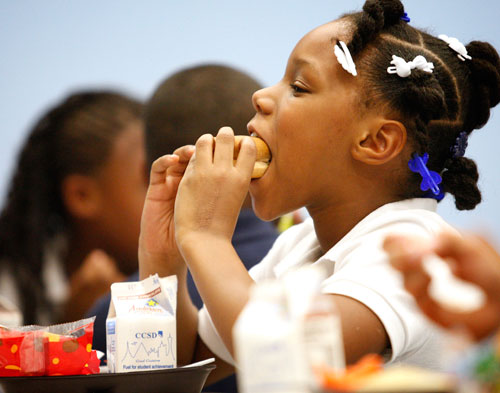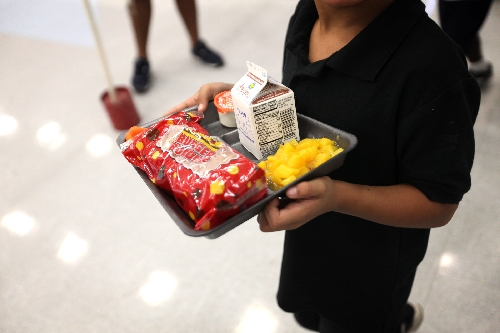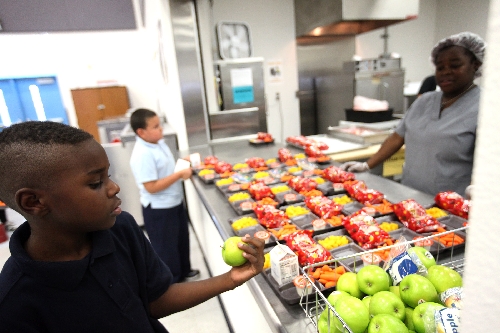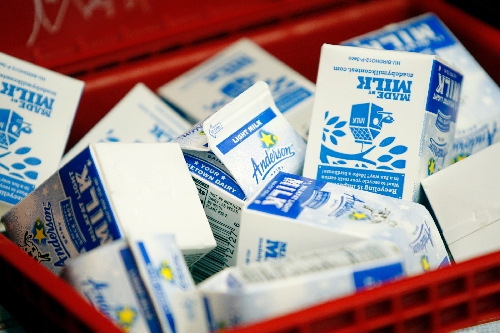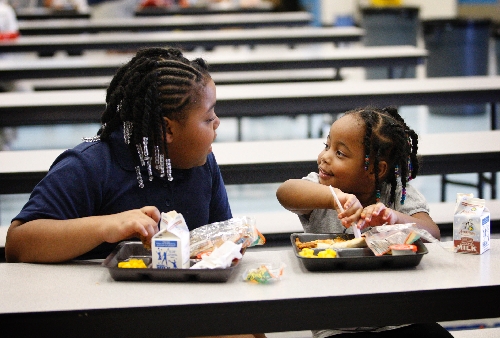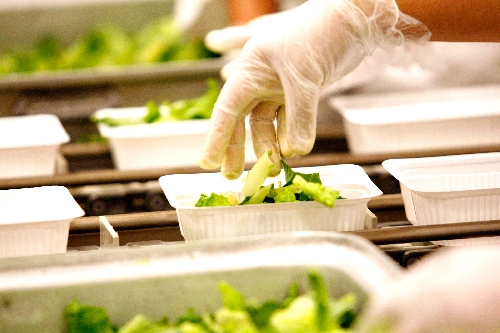School menus must satisfy strict nutritional guidelines, finicky tastes
Imagine running a restaurant that prepares 260,000 meals a day, serves them in 327 dining rooms, is paid 27 cents to $2.86 per meal, has to adhere to a strict set of nutritional guidelines - oh, and has to serve food that kids will eat.
That, in a nutshell, is the food service program of the Clark County School District.
"I think that they have met the challenge, because a lot of kids buy lunch," said Henderson mother Angela Hughes, whose 13-year-old daughter, Mairwen, attends Mannion Middle School.
"It's come a long way since I was in school, in terms of offering reasonably healthy choices for the kids," Hughes added. "It is affordable; it isn't much more than making lunches at home, unless of course the children go nuts. For $15 a week, they get a good lunch."
Virginia Beck, food services director and a registered dietitian, said the district must adhere to the nutritional guidelines set by the U.S. Department of Agriculture.
"They changed drastically this year," Beck said, as a result of the Healthy, Hunger-Free Kids Act of 2010. That mandated an increased consumption of fruits and vegetables, reduced the size of grain servings and reduced calorie consumption, in some cases. Beck said she started working on the changes as soon as the law passed, before the enforcement date went into effect.
"We're meeting all sodium targets," she said. The meals have long "been low-fat, no trans fats. The difference is we started introducing whole grains as well. So we are in very good compliance with the new regulations."
About half of the food consumed in the schools is prepared in the district's central kitchen, which has 150 full-time employees in two shifts, Beck said. Spaghetti sauce, ranch dressing, nacho meat, chicken and noodles, and macaroni and cheese are among the foods that are prepared from scratch and shipped, frozen (because of food-safety factors), to the schools, where it need only be reheated. Some of it's in individual serving trays, some in bulk containers. (While elementary school kitchens just reheat food, high schools make grab-and-go items, such as sandwiches, Beck noted.)
Other food is prepared by outside vendors - with a major difference.
"The commercially prepared food is prepared according to our recipes, so it's not the same thing that you're going to find in your freezer or at the grocery store," Beck said. Corn dogs, for example, are low in sodium and fat and have whole-grain breading.
Nothing served in the schools these days is fried, Beck said. "French fries," for example, are oven-baked.
Tighter nutritional guidelines have pretty much escaped kids' scrutiny over the years, she said: "It has gone over well, because they don't really recognize that it's any different."
And that may apply to parents as well. Madeleine Sigman-Grant, a registered dietitian and maternal and child-health nutrition area specialist with University of Nevada Cooperative Extension, said someone looking at the foods served in school cafeterias may think they're seeing some unhealthy choices.
"A product that might look like pizza to you and me - a normal pizza - might be dramatically different in food composition," Sigman-Grant said. "The issue is that if they were to serve them tofu, the kids aren't probably going to eat it. So serve them a meat product that is much, much lower in fat than the traditional ones you might get at a fast-food store.
"I think the school district's challenge is to make the food look and taste like food that kids will eat."
But the district is making inroads in that direction, Beck said. Last year, the schools introduced fresh fruit at the end of the breakfast and lunch lines, which children can take at will.
"Our fruit consumption has skyrocketed," she said, adding that it may be in part because the kids don't have to take the fruit.
"If I don't have to take it, it must be good," Beck said with a laugh. "So they take it, and they eat it."
The fruit is left whole for older kids and served cut for the smaller ones, she added.
Beck said the district just contracted with a supplier that picks the fruit in California on one day, processes it the next day and gets it to the school district the next.
"So we have fresh fruit and it's just wonderful," she said.
And other healthful choices have been gaining ground, she said; one of the favorites of kids of all ages is teriyaki chicken and vegetables over steamed rice. Another favorite is deli roast potatoes - simply cubed potatoes seasoned and baked.
There are always a few wrinkles that have yet to be worked out. Valley resident Katherine Rowley said when her 14-year-old son, James, was at Hyde Park Middle School, he always brought his lunch because there were long lines to buy, and then he didn't have time to eat.
At Rancho High School this year, she said, he still brought his lunch on the first days, but did buy something - comparatively healthful Chex Mix - from the vending machine.
"He has money on his account," she said. "I did that through the online service, which is very nice."
And Mairwen Hughes isn't totally sold.
"She said some of it's gross, but some of it's OK," Angie Hughes said, adding that Mairwen usually chooses a salad or a chicken sandwich - healthful choices both.
"That," she said, "seems to pretty much be the trend."
Contact reporter Heidi Knapp Rinella at hrinella@review journal.com or 702-383-0474.
LUNCH HELP
Virginia Beck, food services director for the Clark County School District, said parents must register their children for free or reduced-price lunches each year, regardless of whether the kids were in the program the previous year. To register, go to ApplyForLunch.com.



